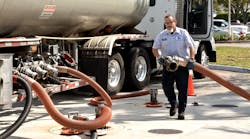NTTC enters national spotlight amid summer gasoline shortage scare
There’s no shortage of tasks to keep Ryan Streblow and his staff busy these days.
In addition to working with a new administration to further its legislative and regulatory agenda, and preparing for the 2021 National Tank Truck Carriers (NTTC) Annual Conference—the association’s first in-person meeting in more than a year—NTTC’s interim president now is inundated with calls from mainstream media following CNN’s story on how a shortage of tank truck drivers could cause gasoline stations to run out of gas.
Citing NTTC’s estimate that 20% to 25% of tanks trucks, including those that haul fuel, are parked heading into the summer, due to many contributing factors, the report warned people looking forward to pandemic-delayed road trips may have a hard time fueling their vehicles—a terrifying thought for many stir-crazy Americans.
It’s also one that Streblow is all too familiar with.
While it’s true fewer fuel-hauling trucks were parked at this time in 2019, and the pandemic is a factor on several levels, so is the Federal Motor Carrier Safety Administration’s new Drug & Alcohol Clearinghouse, which has sidelined nearly 50,000 drivers; and the underlying issue—a severe driver shortage—is nothing novel to the overall trucking industry.
“We’re all searching for good, qualified professional drivers,” Streblow said.
“The one that’s making the news right now is the petroleum side, because gas is the No. 1 commodity in the world. It’s one we can all relate to, so it gets the greatest visibility. But these shortages are across the board.”
Still, experts agree the pandemic exacerbated driver shortages.
Truck driving schools and state driver’s license agencies closed—and with lockdowns and remote working, demand for gas plummeted.
“The near-term shortage in fuel haulers is a result of the decreased fuel amount used during the pandemic,” said Ronald Greene, owner of Regional Express Carriers, and vice president of business development for Overhaul, a real-time visibility and risk-management technology provider. “Americans drove over 200 billion fewer miles in 2020 than in 2019, and many tanker drivers were laid off during the pandemic or transitioned to other roles. That said, as consumers start to drive more, the amount of fuel is increasing, hence the need for additional drivers.”
But, as American Trucking Associations pointed out in its 2019 Truck Driver Shortage Analysis, a shortfall of drivers first was documented way back in 2005. At that time, ATA said, the shortage was only 20,000. The number had skyrocketed to more than 50,000 by 2017—well before COVID-19 reached the United States.
“It truly is a driver shortage,” Streblow stressed. “With our country sitting on 30 to 35 days of fuel reserves, that’s not the issue. The issue is the 24 to 48 hours’ worth of reserves that you find at any given station, where consumers are able to access that particular commodity. So it’s not a gas shortage, and I’ve been working my way through the media, clarifying that it’s a capacity constraint based on transporting gasoline.”
The shortage isn’t exclusive to the petroleum-hauling tank segment either. Chemical carriers also face capacity constraints, along with foodgrade, dry bulk haulers and others.
“We have a lot of tank truck companies that could use professional drivers right now, and there are a lot trucking companies across all segments that could use good, qualified truck drivers,” Streblow said. “So it’s really an opportunity for the country. When we look at coming out of the pandemic, and we see folks trying to get back into the workforce by examining other career opportunities, it’s important for them to understand that we have an industry that can be incredibly lucrative for someone. We’re a very loyal industry, and we can provide solid opportunities for people to get back to work. And it’s not about creating jobs.
“These jobs are already there. They exist right now.”
Streblow argues the key to reducing the U.S. unemployment rate, which stayed at 6.1% in the Bureau of Labor Statistics’ April report, is for more people to obtain a commercial driver’s license (CDL)—and the proper tank-hauling endorsements, of course—and view the trucking industry as a viable alternative to other career paths.
“Unfortunately, there isn’t necessarily a silver bullet that’s going to cure this problem,” Streblow said. “We’re going to do what we can to continue to promote the image of the tank truck industry. And historically speaking, we’re a point of destination for many professional drivers. There are a lot of benefits for drivers in the tank truck industry, as far as their compensation. And guys on the petroleum side are hauling on a daily basis, so for a driver looking to move from over-the-road, it’s a great option to consider.”
One short-term solution NTTC insists isn’t viable: An hours-of-service waiver for fuel haulers.
Four major trade organizations, the National Association of Truckstop Operators, the National Association of Convenience Stores, the Energy Marketers of America, and the Society of Independent Gasoline Marketers of America, recently asked the FMCSA to issue a new hours-of-service waiver that includes truckers who deliver fuel, arguing it’s an essential part of the supply chain that’s especially important during a pandemic.
But the tank truck carriers’ industry association isn’t on board.
“National Tank Truck Carriers does not support an hours-of-service waiver as a solution to the truck driver shortage,” Streblow emphasized. “And we’ve had conversations directly with FMCSA, communicating that to them as well. One of the core pillars of our association is a focus on safety, and yes we are combating a driver shortage issue, but in no way, shape or form are we going to sacrifice safety for our professional drivers or the motoring public, for that matter, to get a commodity from Point A to Point B faster.”
This article originally appeared on Bulk Transporter.




